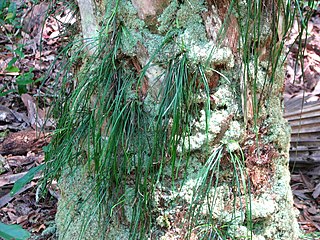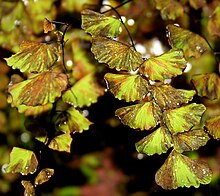
Equisetales is an order of subclass Equisetidae with only one living family, Equisetaceae, containing the genus Equisetum (horsetails).

Marattiaceae is the only family of extant (living) ferns in the order Marattiales. In the Pteridophyte Phylogeny Group classification of 2016, Marattiales is the only order in the subclass Marattiidae. The family has six genera and about 110 species. Many are different in appearance from other ferns, having large fronds and fleshy rootstocks.
The Pteridales were an order of ferns that have their sori in linear strips under the edge of the leaf tissue, usually with the edge of the lamina reflexed over.

Blechnaceae is a family of ferns in the order Polypodiales, with a cosmopolitan distribution. Its status as a family and the number of genera included have both varied considerably. In the Pteridophyte Phylogeny Group classification of 2016, the family has 24 genera, and excludes genera placed in the separate family Onocleaceae. The family is divided into three subfamilies, including Blechnoideae s.s. Alternatively, the entire family may be treated as the subfamily Blechnoideae s.l. of a very broadly defined family Aspleniaceae, and include genera others place in Onocleaceae.

Pteridaceae is a family of ferns in the order Polypodiales, including some 1150 known species in ca 45 genera, divided over five subfamilies. The family includes four groups of genera that are sometimes recognized as separate families: the adiantoid, cheilanthoid, pteridoid, and hemionitidoid ferns. Relationships among these groups remain unclear, and although some recent genetic analyses of the Pteridales suggest that neither the family Pteridaceae nor the major groups within it are all monophyletic, as yet these analyses are insufficiently comprehensive and robust to provide good support for a revision of the order at the family level.

The Athyriaceae are a family of terrestrial ferns in the order Polypodiales. In the Pteridophyte Phylogeny Group classification of 2016 (PPG I), the family is placed in the suborder Aspleniineae, and includes two genera. Alternatively, it may be treated as the subfamily Athyrioideae of a very broadly defined family Aspleniaceae. The family has with a cosmopolitan distribution.

Onocleaceae is a small family of terrestrial ferns in the order Polypodiales. It is placed in the suborder Aspleniineae in the Pteridophyte Phylogeny Group classification of 2016. Alternatively, the family, along with Blechnaceae, may be placed in a very broadly defined family Aspleniaceae as the subfamily Blechnoideae. The family may contain from one to four genera, consisting of five species largely in north temperate climes. The four genera, Matteuccia, Onoclea, Onocleopsis and Pentarhizidium, may be included under the single genus Onoclea.

Vittaria, the shoestring ferns, is a genus of ferns in the Vittarioideae subfamily of the family Pteridaceae. It had previously been placed in the family Vittariaceae, but that family is no longer recognized.

Antrophyum is a genus of ferns in the family Pteridaceae. They are commonly known as lineleaf ferns.

Llavea is a monotypic genus of fern in the family Pteridaceae. The sole species is Llavea cordifolia. It is often cultivated as an ornamental foliage plant. The genus was named in honour of Pablo de La Llave, a Mexican naturalist.

Tectariaceae is a family of leptosporangiate ferns in the order Polypodiales. In the Pteridophyte Phylogeny Group classification of 2016 (PPG I), the family is placed in the suborder Polypodiineae. Alternatively, it may be treated as the subfamily Tectarioideae of a very broadly defined family Polypodiaceae sensu lato. The family comprises seven genera, of which Tectaria is by far the largest.

Polypodioideae is a subfamily belonging to the fern family Polypodiaceae, which is a member of the suborder Polypodiineae in the Pteridophyte Phylogeny Group classification of 2016 (PPG I). Alternatively, the subfamily may be treated as the tribe Polypodieae within a very broadly defined family Polypodiaceae sensu lato.

Cryptogrammoideae is a subfamily of ferns in the family Pteridaceae. The subfamily contains three genera and about 23 species.

Parkerioideae, synonym Ceratopteridoideae, is one of the five subfamilies in the fern family Pteridaceae. It includes only the two genera Acrostichum and Ceratopteris. The following diagram shows a likely phylogenic relationship between the two Parkerioideae genera and the other Pteridaceae subfamilies.

Antrophyopsis manniana is a species of the genus Antrophyopsis, a vittarioid fern occurring in the African rain forest and montane forest of East Africa and the Albertine Rift.
Haplopteris is a genus of vittarioid ferns, a member of subfamily Vittarioideae and family Pteridaceae.
Antrophyopsis is a genus of vittarioid ferns, a member of subfamily Vittarioideae and family Pteridaceae. Like other vittarioids, ferns in the genus are epiphytes with simple, straplike leaves. They are native to tropical Africa and islands of the Indian Ocean. The presence of a midrib in their leaves, the shape of their spores, and the shape of cells at the tip of their paraphyses help to distinguish members of the genus from other vittarioids. The group was raised to the level of genus in 2016.
Radiovittaria is a genus of ferns in the subfamily Vittarioideae of the family Pteridaceae. Species are native to southeast Mexico and northern Southern America.
Rheopteris is a genus of ferns in the subfamily Vittarioideae of the family Pteridaceae with a single species, Rheopteris cheesmaniae, in the Pteridophyte Phylogeny Group classification of 2016. Other sources sink the genus into Monogramma, a genus not recognized in PPG I. The species is native to New Guinea.
Vaginularia is a genus of ferns in the subfamily Vittarioideae of the family Pteridaceae in the Pteridophyte Phylogeny Group classification of 2016. Other sources sink the genus into Monogramma, a genus not recognized in PPG I.














